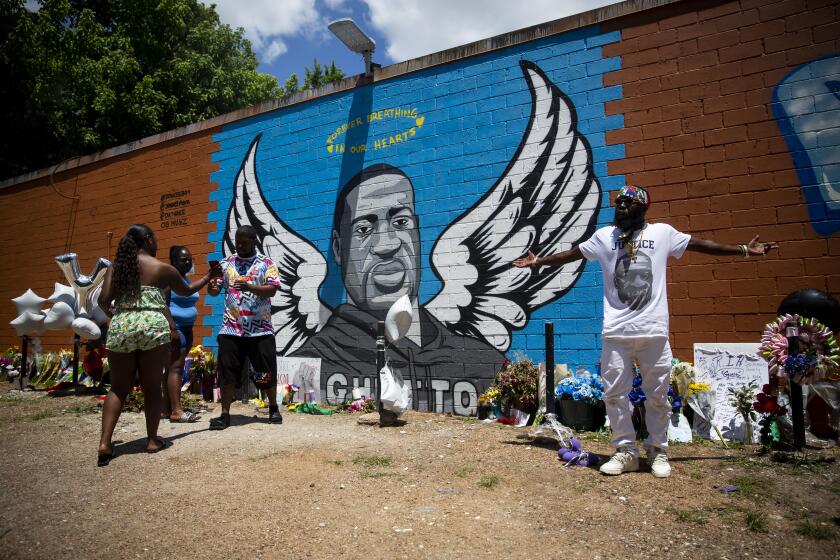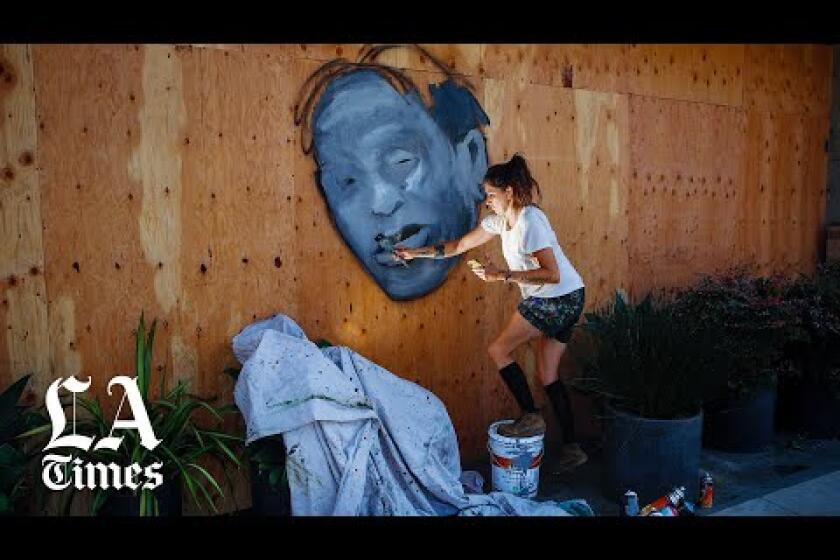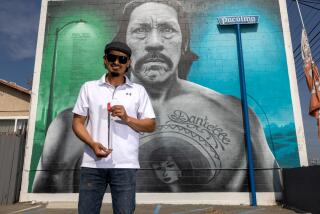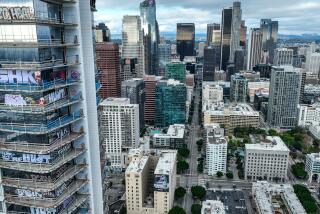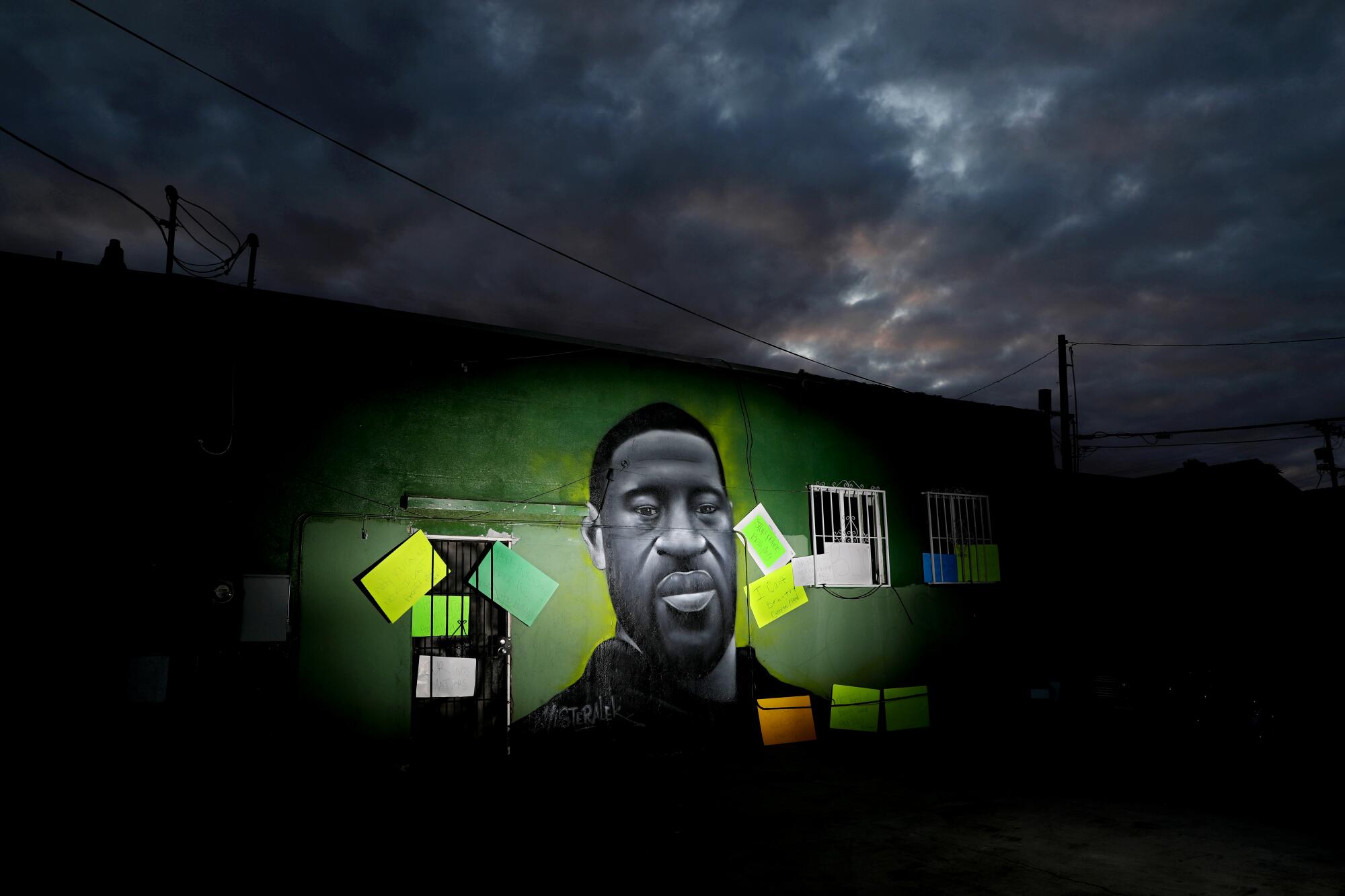
The day Jules Muck heard about George Floyd’s death, she couldn’t sleep. So at 3 a.m., the restless artist began painting an image of him on a U.S. casket flag she found in her Venice home.
An idea had gripped her mind: That murals of Floyd, who died after a Minneapolis police officer pinned his neck down with his knee, “had to be everywhere.”
Muck, who goes by MuckRock, couldn’t just pick one location. So she painted more than a dozen mostly around Venice. On Abbot Kinney and Lincoln boulevards, she spray-painted Floyd’s face in black and white and sometimes blue.
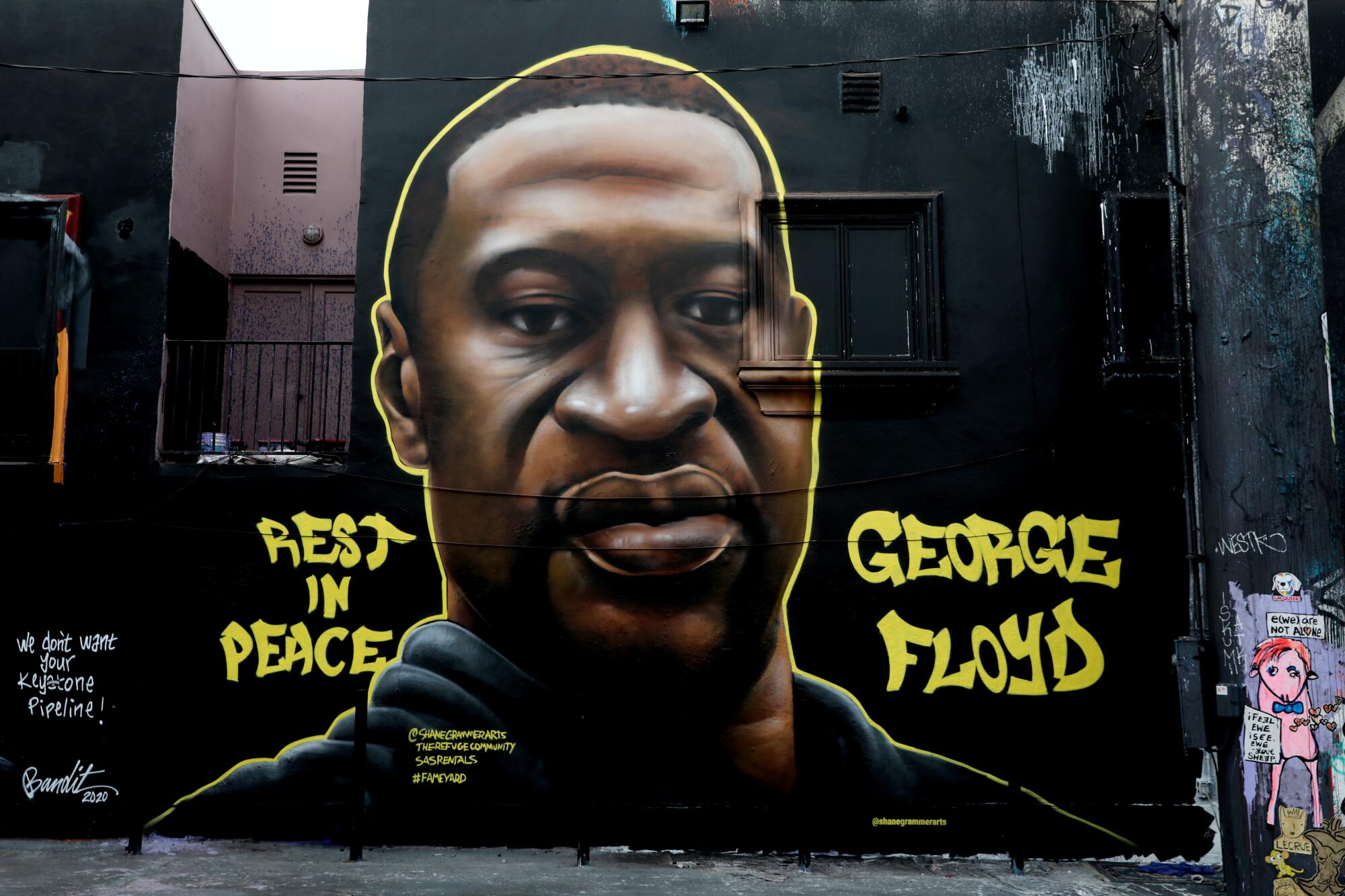
“I’m trying to offer comfort to people that are upset, but this is also a way to say ‘We’re with you. We agree this is unjust. We want justice,’ ” she said. “We’re trying to be open and listen and show solidarity to this movement.”
George Floyd, a 46-year-old Black man, died May 25 in Minneapolis after Derek Chauvin, a white police officer, had his knee on Floyd’s neck for nearly nine minutes. As he lay on his stomach, Floyd pleaded: “I can’t breathe.”
On Tuesday, Floyd was buried next to his mother, Larcenia Floyd, in Houston, where he was raised.
Before George Floyd, 46, died at the hands of Minneapolis police, he had managed to extricate himself from the Houston projects.
His death, which has now resulted in charges against four officers — including second-degree murder charges against Chauvin — sparked national outrage and widespread protests.
A Watts resident who goes by Misteralek also wanted to commemorate Floyd. Last week, as protesters peacefully marched through the streets of Hollywood and downtown L.A., Misteralek was painting a mural of Floyd outside a Watts’ convenience store.
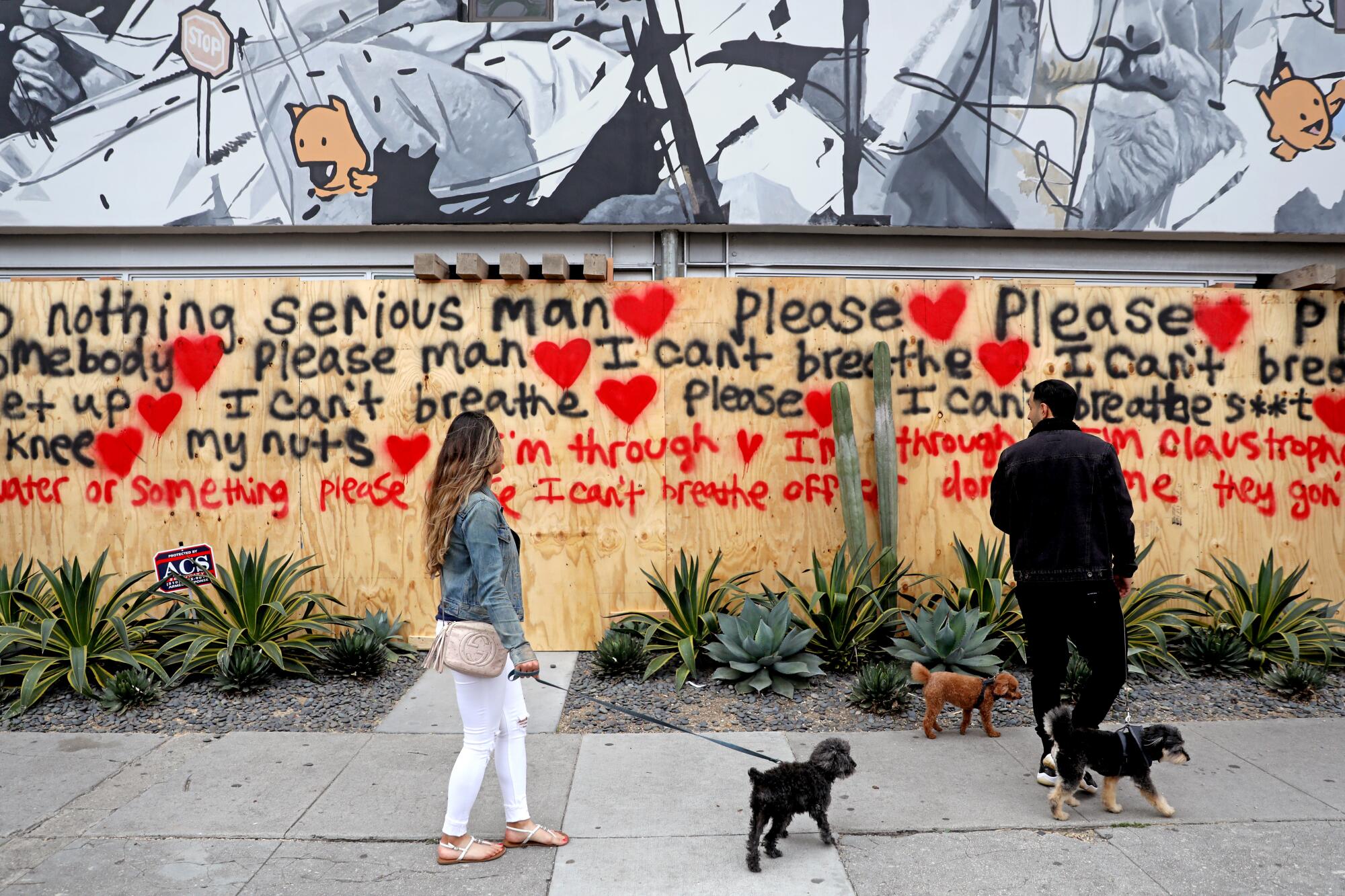
“Every time something like this happens, I feel like I have to express myself through art,” said Misteralek, 31. “I like painting portraits, and it’s something that means a lot to people over here.”
From morning to sundown, while he colored Floyd’s face with black and white spray paint, people expressed their gratitude: Cars honked. People stopped to watch or chat or offer him a drink. They thanked him.
“It’s my way of speaking up,” the artist said.
As Steven Rounnel walked out of Supreme Beauty Supply next door, he said Floyd’s portrait is a reminder that major change is long overdue.
“We need equality for everybody,” said the 49-year-old barber. “Not just Blacks, but everybody. Everybody is getting abused by the system.”

L.A. has long been a city of street murals. Vivid portraits of Kobe Bryant, Nipsey Hussle, the Rev. Martin Luther King Jr., La Virgen de Guadalupe and Rosa Parks decorate buildings, alleys and busy highways.
Murals in L.A. emerged in the 1960s and 1970s as political and personal art statements in areas like Venice and South L.A. By the mid-’80s to the early 2000s, the city had become the world’s mural metropolis, until a lawsuit led to a citywide ban in 2002. A decade later it was lifted, and public artwork reemerged.
Outside the boarded-up Blue Moon & Co., a jewelry shop on South Broadway in downtown L.A., was another portrait of Floyd. Nearby stood several armed National Guard troops keeping watch over the area, which had been damaged by looters days earlier during a protest.
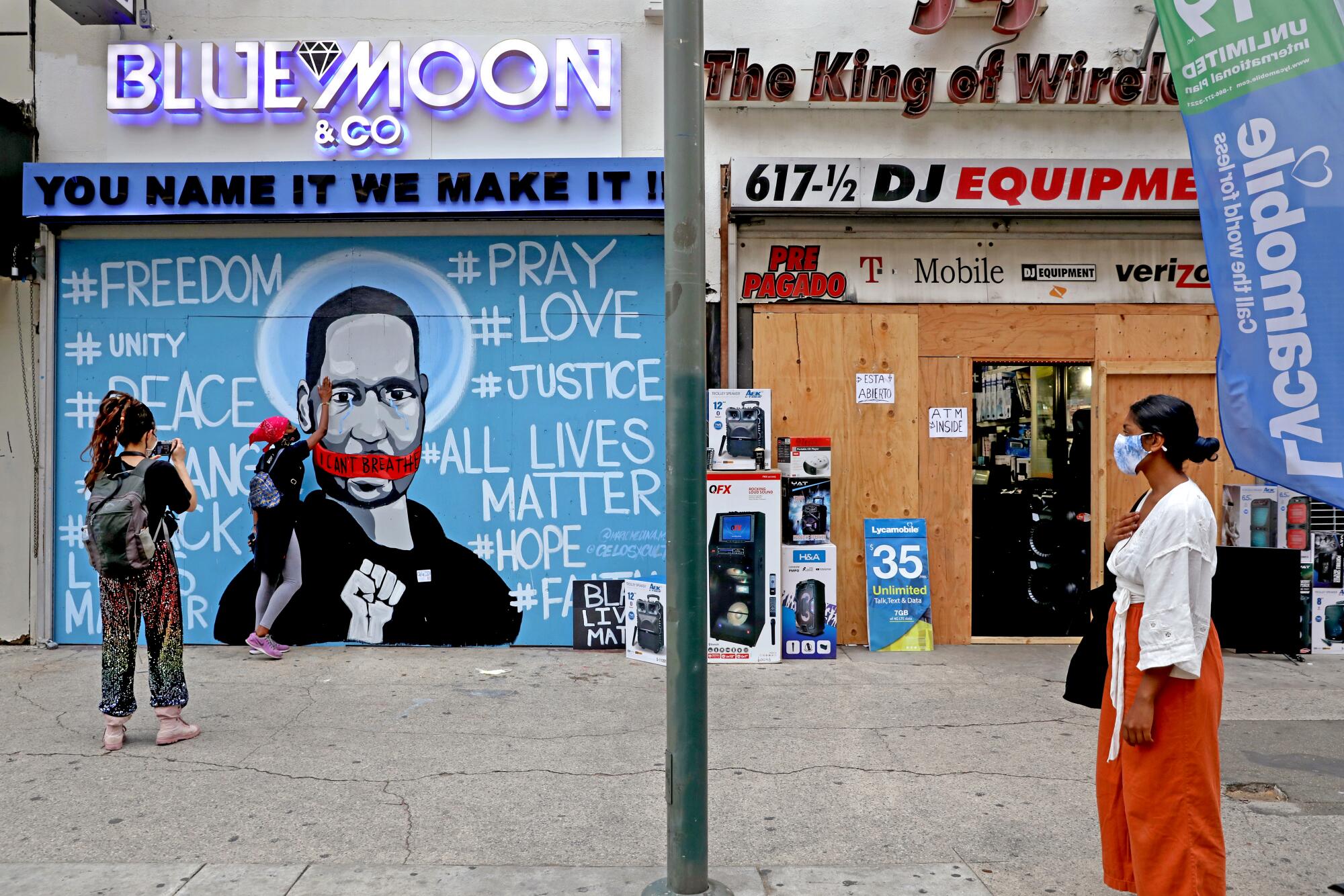
In the piece, a halo is suspended above Floyd’s crying face; his mouth is covered with red tape, which bears the words: “I can’t breathe.” A clenched fist rises from beneath the mural, and scrawled around him are the hash-tagged words: Freedom. Unity. Peace. Change. Black Lives Matter. Pray. Love. Justice. All Lives Matter. Hope. Faith.
Mario Medina, who created the mural with assistance from artist Celos, dropped what he was doing May 30 when the shop’s owner gave him permission to paint on his storefront. Without a layout or plan, they rushed over and got to work around 4 p.m.
But they were on edge the entire time, said the 29-year-old from Maywood.
“Our backs were facing the street and we had a time frame because of the curfew,” which went into effect at 8 p.m. because of ongoing protests. As the day grew darker and the clock ticked closer to curfew, they could hear sirens and chants get louder. At 7:45 p.m., they finished.
“It came together on the fly, and what you got was how we felt about the situation right in the moment,” said Medina.
Walking down Broadway on a recent Thursday afternoon, Omar Gonzalez stopped to take a video of the blue mural. It took him a few days to track down its location, but when he did, he made sure to wear his “Justice for George Floyd” T-shirt.
“I think as Latinos, and me being Mexican American first generation, I think it was important for us to say ‘Hey, we got you guys’” to the Black community, said the 34-year-old from Santa Fe Springs.
Gonzalez, a personal trainer, plans to do workout videos in his Floyd T-shirt with a Mexican flag tied around his waist.
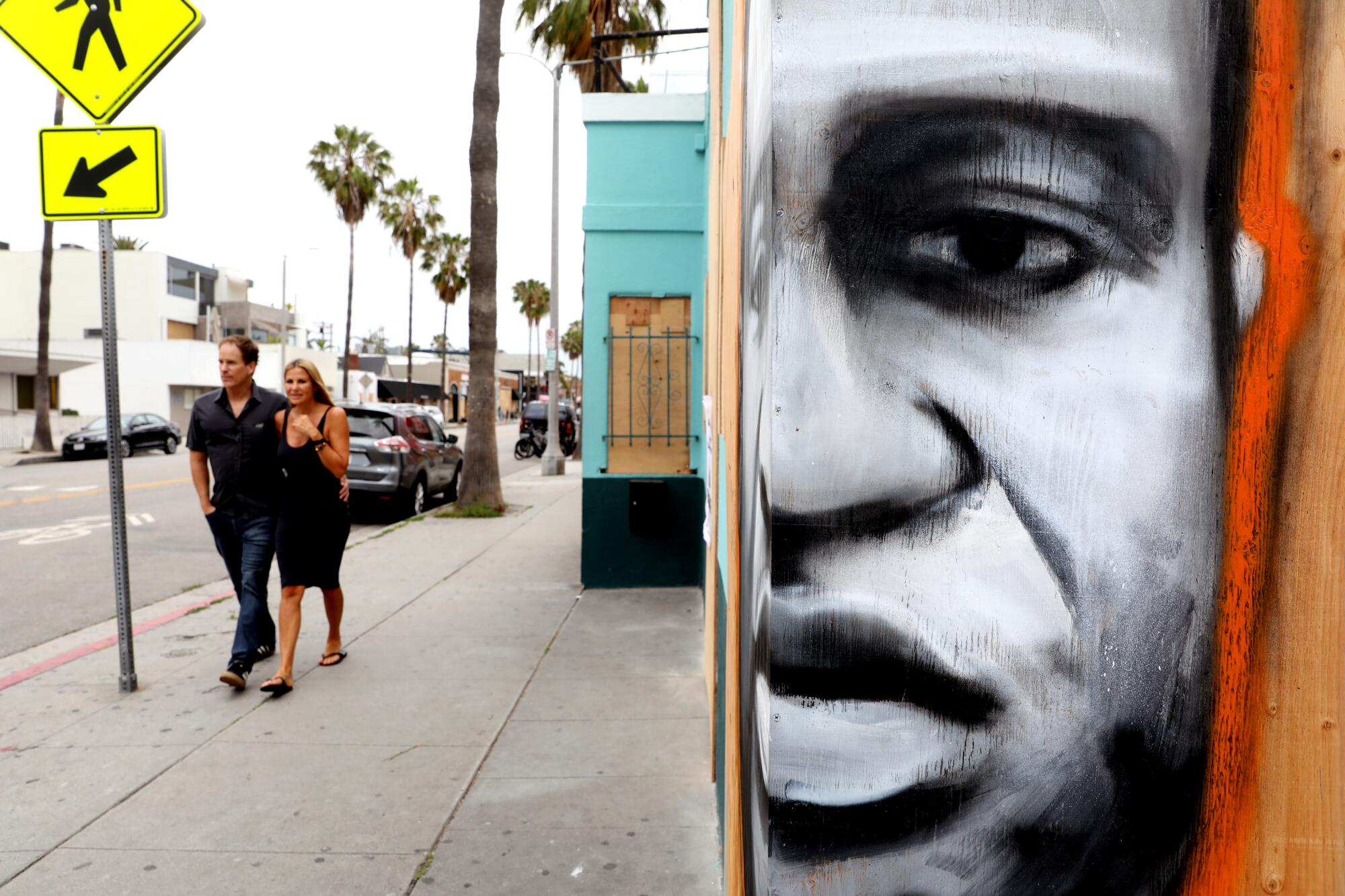
“I think it was a big responsibility for a lot of us who grew up with Black people” to show solidarity and support, he said.
Outside Broadway Snack Bar, owner Cemal Cemalk, 56, recalled the night before the mural went up. The owner of Blue Moon & Co. next door stood outside his shop with others to protect the store, guns in hand.
“The second day [of protests], the owner closed the store, put up the plywood” and the mural was painted.
“Across the street, [looters] broke windows and stole everything, but this store, nobody touched” he said, pointing at the shop with Floyd’s portrait.
Back in Venice, Muck had lost count of how many portraits of Floyd she’s painted since he was killed, but she knows it’s more than a dozen.
Some businesses called on her to paint him on their boarded-up store fronts, but in some cases, she sought the walls herself. Floyd is the latest Black life lost that Muck has painted: Sandra Bland, Trayvon Martin, Michael Brown and Breonna Taylor (“She’s so gorgeous that it’s a pleasure to paint her,” Muck said of Taylor, who was killed in March when Louisville police, executing a search warrant, broke down her apartment’s door and shot her eight times.)
In collaboration with shop owners, Muck said she’s offered to give away the portraits as they come down to people who “donate substantially” to charities that benefit Black communities.
Down Abbot Kinney Boulevard, where National Guard troops stood guard along the street, messages on business walls read: “End white silence,” “Black lives matter” and “We see you. We hear You. We stand w/u.”
Written outside the vintage clothing store Bazar were some of the last words Floyd cried out before he died: “Please, man, I didn’t do nothing serious.”
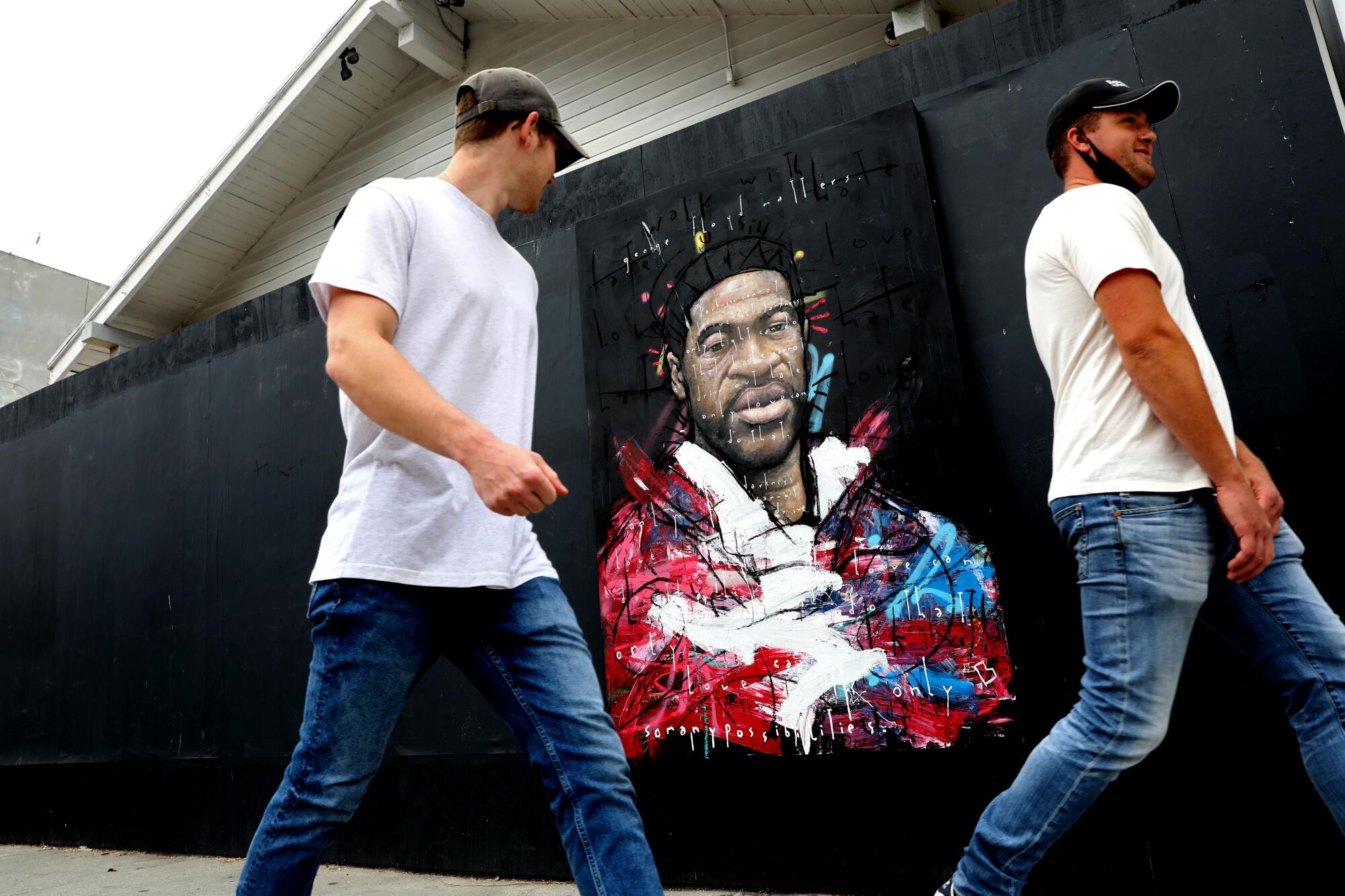
Irma Hawkins was walking her black poodle Bodhi when she stopped to admire a colorful, unsigned canvas painting of Floyd. She stepped onto the street to have a better look.
“It’s beautiful,” she said beneath a red face covering. “It’s just beautiful.”
Hawkins, a 69-year-old Venice resident, was working on a Floyd art piece at home, too. She had just listened to former President Obama’s speech calling on mayors to review police use-of-force policies and make other reforms to combat racism.
She knows how powerful art can be. “It’s a sanctuary for your sorrow,” she said. “It’s a way to unite.”
Muralist Jules Muck, known as MuckRock, is donating her time to to honor black victims of racial injustice.
More to Read
Sign up for Essential California
The most important California stories and recommendations in your inbox every morning.
You may occasionally receive promotional content from the Los Angeles Times.
